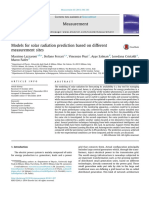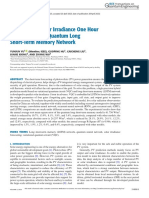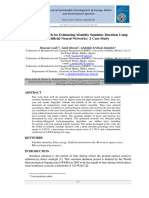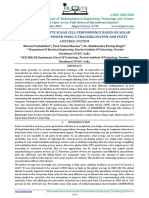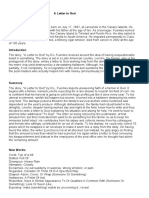IJCRT2405665
IJCRT2405665
Uploaded by
Yashwanth YashCopyright:
Available Formats
IJCRT2405665
IJCRT2405665
Uploaded by
Yashwanth YashOriginal Description:
Copyright
Available Formats
Share this document
Did you find this document useful?
Is this content inappropriate?
Copyright:
Available Formats
IJCRT2405665
IJCRT2405665
Uploaded by
Yashwanth YashCopyright:
Available Formats
www.ijcrt.
org © 2024 IJCRT | Volume 12, Issue 5 May 2024 | ISSN: 2320-2882
AUTOMATED ARCHITECTURE DESIGN FOR
SOLAR IRRADIANCE PREDICTION
Mrs. SUSHMA V, Ms. AMRUTHA, Ms. LIKITHA B, Mr. YASHWANTH M, Mr. AKSHAY GOWDA S
G
ASSISTANT PROFESSOR , STUDENT, STUDENT, STUDENT, STUDENT
COMPUTER SCIENCE AND ENGINEERING,
ATME COLLEGE OF ENGINEERING, MYSURU, INDIA
Abstract: Precise estimation of solar radiation required for a continuous flow of electrical power has always
been a challenging undertaking, in the domains of artificial intelligence and physical simulation. Power grid
operators would find it simpler to take preventative measures ahead of time to guarantee failsafe outcomes
during instances of abrupt or cascading drops in solar energy if solar irradiance could be predicted with
extremely high precision. This paper used historical meteorological data from two consecutive years to
forecast hourly solar irradiance of Johannesburg city using three machine learning techniques. The objective
was to develop a model that could easily make use of historical meteorological data in order to forecast
extremely precise hourly solar irradiance data. According to the results, Random Forest using normalized root
mean square.
Index Terms - Solar Irradiance prediction, machine learning, Random Forest.
Introduction
Renewable energy integration into power systems has attracted great interest in recent years because of the
growing demand for electricity, the aim to diversify the energy basket in most of countries, and the need to
reduce CO2 25 emissions 26 by protecting the environment. Because energy consumers rely heavily on fossil
fuels, the world's supply of these resources is running out. Because they release harmful gases into the
atmosphere, fossil fuels, being non-renewable energy sources, have a negative impact on the environment by
causing pollution and climate change. Only when dependable substitutes for fossil fuels are created will the
overreliance on them begin to decrease.
Recently, solar energy has become more popular all over the world . Its accessibility and advancements in
photovoltaic (PV) cell technology are to blame for this. Solar energy is an abundant and clean energy source
that has minimal impact on the environment .Many investments have been made worldwide to increase solar
power efficiency, which has led to the development of technologies that have produced new kinds of cell
candidates to take the place of the more conventional and costly crystal silicon cells. Thin-Film and
Multijunction Cell technologies are two examples of these new cell candidates. Solar power is now one of the
most practical renewable energy sources thanks to this technological trend and the global effort to reduce
greenhouse gas emissions. The key concept in the field of solar power production is solar irradiance It is the
solar energy released, manifested as a broad range of light waves. In a nutshell, it's the amount of power
(W/m^2) that is obtained from the sun's electromagnetic radiation. It is the solar radiation that is emitted and
manifested as a broad range of light waves. To put it simply, it is the amount of power (P/A) that is received
from the sun in the form of electromagnetic radiation. In a nutshell, electromagnetic fields cause vibrations that
are represented by light waves.
IJCRT2405665 International Journal of Creative Research Thoughts (IJCRT)www.ijcrt.org g184
www.ijcrt.org © 2024 IJCRT | Volume 12, Issue 5 May 2024 | ISSN: 2320-2882
The sun radiation that enters the atmosphere is filtered mostly by organic substances like nitrous oxide, ozone,
water vapor, and carbon (IV) oxide. The atmospheric matter absorbs, emits, and scatters incident solar radiation
as a result of these interactions. While scattering causes the radiative energy to be redistributed in all directions,
absorption of incident radiation results in a reduction of radiative energy moving at the incident angle. Solar
radiation is the energy that, in the end, makes its way to the photovoltaic (PV) cells through the interaction of
radiation and matter. This paper will use machine learning techniques to predict the amount or intensity of solar
radiation. solar power generation is an intermittent process, accurate forecasting of solar irradiance is crucial
for grid operators and solar power supply companies alike. Grid operators need prediction data in order to
create supply-demand plans that minimize power outages. This can be done by creating a backup plan for
electricity generation based on the prediction data, which will provide fail safe scenarios in the event of
cascading power outages caused by variations in solar radiation. In order to predict hourly solar irradiance in
this work, historical meteorological data was acquired as input parameters via subscription from the Meteoblue
website. The measured (actual) GHI, sunshine duration, temperature, and relative humidity are among the data.
Two years' worth of data were used. Support vector regression (SVR), random forest (RF), and artificial neural
network (ANN) are the three machine learning techniques that were applied.
I. EXPERIMENTAL SET UP
For an accurate prediction, the training data's composition and quality, as well as the data's source, are
essential. Meteoblue provided meteorological weather data for Johannesburg, which was used in this paper.
We used hourly data from 2017 and 2018, two years in a row. The data were cleaned before being used, with
all nighttime data that included zero measured solar irradiance (SI/d) removed. Only daily data from 7 a.m.
to 6 p.m. was used. The three models were trained independently using data from each of these years, and the
outcomes were then compared. 30% of the data were designated as testing data, and the remaining 70% as
training data. The following parameters are present in the dataset and were used as input:
a. Temperature at two meters above sea level
b. Relative humidity at an elevation of two meters
c. Duration of sunshine and
d. Solar radiation measurements
The general process input data were split, pre-processed, and fed into the three machine learning algorithms
in order to produce a prediction, as the chart in figure 1 below shows.
II. Flow chart
Fig 1 : Flow chart explaining process of predictions using ML models
A chart showing the general process used to generate predictions using the three ML models
Below is a brief description of the three machine learning models used to predict hourly solar irradiance of
Johannesburg city:
IJCRT2405665 International Journal of Creative Research Thoughts (IJCRT)www.ijcrt.org g185
www.ijcrt.org © 2024 IJCRT | Volume 12, Issue 5 May 2024 | ISSN: 2320-2882
Linear regression:
By fitting a linear equation to observed data, the statistical technique known as linear regression is used to
model the relationship between a dependent variable and one or more independent variables. The objective is
to identify the hyperplane or straight line that "best fits" the data to depict the relationship between the variables.
Simple linear regression is the most basic type of linear regression; multiple linear regression is the most
complex type of regression involving multiple independent variables.
The equation of a simple linear regression model can be represented as:
Random forest regression:
Random forest regression is a supervised learning algorithm that performs regression using the ensemble
learning technique. In order to produce a prediction that is more accurate than one from a single model, the
ensemble learning method combines predictions from several machine learning algorithms.
During the training phase, a Random Forest builds multiple decision trees, with the mean of the classes serving
as each tree's prediction. Let's go through the steps of the Random Forest algorithm to better understand it:
Choose k data points at random from the training set.
Construct a decision tree for these k data points.
For regression tasks, the Random Forest Regression is a well-liked ensemble learning technique. It is
predicated on the idea of decision trees, in which various decision trees are trained on various data subsets
and the average of their predictions is used to generate the final result.
A Random Forest Regression operates as follows:
Random Subset Selection: A random subset of the training data is sampled with replacement before each tree
in the forest is constructed. We call this procedure "bootstrapping."
Random Feature Selection: A random subset of features is taken into consideration for splitting at each
decision tree node. This strengthens the model's resistance to over fitting and aids in decor relation of the
trees.
Tree Building: Every decision tree is expanded to its greatest depth or until a predetermined threshold is
reached. The feature that maximizes the mean squared error or variance reduction is used to split the nodes.
Ensemble Prediction: Following the construction of each tree, predictions are generated by adding together
the predictions of each individual tree. Predictions for regression tasks are usually averaged over all trees.
IJCRT2405665 International Journal of Creative Research Thoughts (IJCRT)www.ijcrt.org g186
www.ijcrt.org © 2024 IJCRT | Volume 12, Issue 5 May 2024 | ISSN: 2320-2882
Gradient Boosting for Classification and Regression:
Loss Function (L): The difference between the actual and predicted values is measured by this function. The
deviance (negative log-likelihood) or another suitable loss function, such as exponential loss for AdaBoost,
is frequently used for classification tasks, whereas the mean squared error (MSE) is the typical loss function
for regression tasks.
Weak Learner (h): A decision tree is usually used as a weak learner, and it is trained to predict the residuals,
or the discrepancies between the ensemble's previous predictions and the actual values. The predictions of the
weak learner are represented by ℎh(x).
Ensemble Prediction (F): This is the total of all the weak learners' predictions, weighted by a shrinkage
parameter (learning rate). Every time a new weak learner is added to the ensemble, its prediction is first
multiplied by the learning rate. This process is repeated for each iteration. The group forecast is represented
by the symbol F(x).
Update Rule: The weak learner is trained to predict the loss function's negative gradient in relation to the
ensemble prediction for each iteration. The pseudo-residual is the name given to this negative gradient. The
predictions of the weak learner are then added to the ensemble prediction after being scaled by a factor known
as the learning rate. Usually, the update rule is provided by:
III. Result and discussion
Fig 2 : Accuracy Graph
Classifier Accuracy
Linear Regression 62.97%
Elastic Net 62.56%
Random Forest Regressor 93.44%
Gradient Boosting Regressor 88.50%
IJCRT2405665 International Journal of Creative Research Thoughts (IJCRT)www.ijcrt.org g187
www.ijcrt.org © 2024 IJCRT | Volume 12, Issue 5 May 2024 | ISSN: 2320-2882
The comparison of regression models for predicting solar irradiance is crucial for ensuring the accuracy and
reliability of solar energy forecasting systems. In this evaluation, four regression models were assessed: Linear
Regression, Elastic Net, Random Forest Regression, and Gradient Boosting Regression.
Linear Regression and Elastic Net are traditional linear models commonly used for regression tasks. However,
they may struggle to capture complex non-linear relationships present in solar irradiance data, leading to lower
accuracy. As observed in this analysis, both Linear Regression and Elastic Net achieved accuracies of around
62-63%, indicating their limited performance in this context.
On the other hand, Random Forest Regressor and Gradient Boosting Regressor are ensemble learning
techniques capable of capturing non-linear relationships and interactions within the data. Random Forest
Regressor constructs multiple decision trees and combines their predictions to produce more robust results.
Gradient Boosting Regressor sequentially builds an ensemble of weak learners, with each new model focusing
on the mistakes of the previous ones, thereby improving accuracy.
The results of the evaluation demonstrate the superior performance of Random Forest Regressor and Gradient
Boosting Regressor compared to linear models. Random Forest Regression achieved an impressive accuracy
of 93.44%, indicating its ability to effectively model the complex patterns present in solar irradiance data.
Gradient Boosting Regression also performed well with an accuracy of 88.50%, albeit slightly lower than
Random Forest Regression.
In conclusion, for accurate prediction of solar irradiance, the Random Forest Regression emerges as the most
suitable model among those evaluated. Its superior accuracy suggests that it can effectively capture the
intricate relationships and variability inherent in solar irradiance data, making it a valuable tool for solar
energy forecasting applications. However, the choice between Random Forest Regression and Gradient
Boosting Regression may depend on factors such as computational resources, interpretability, and specific
requirements of the forecasting task.
Fig 3 :User interface to provide inputs Fig 4 :output interface which
predicts radiation
IV. CONCLUSION
The use of solar power has become more and more accepted worldwide in recent years as a clean, sustainable,
and dependable replacement for fossil fuels. This momentum, though, can only be maintained if PV cell
power generation efficiency is constantly increased. In addition to technological advancements such as the
maximum power point tracking (MPPT) mechanism, which enables the system to maximize power output
from each incoming radiative energy, there is a need for improved accuracy in solar irradiance prediction.
The grid operators will be able to get over the uncertainties brought on by variations in the daily climate and
weather patterns, which have a significant impact on solar power generation, by developing a trustworthy
forecasting model.
IJCRT2405665 International Journal of Creative Research Thoughts (IJCRT)www.ijcrt.org g188
www.ijcrt.org © 2024 IJCRT | Volume 12, Issue 5 May 2024 | ISSN: 2320-2882
V. REFERENCES
[1] A. M. Farayola, A. N. Hasan, and A. Ali, “Efficient photovoltaic MPPT system using Coarse Gaussian
support vector machine and artificial neural network techniques,” International Journal of Innovative
Computing Information and Control (IJICIC), vol. 14, no. 1, 2018.
[2] R. Zhang, M. Feng, W. Zhang, S. Lu, and F. Wang, “Forecast of solar energy production-A deep learning
approach,” presented at the 2018 IEEE International Conference on Big Knowledge (ICBK), 2018, pp. 73–
82.
[3] A. M. Farayola, A. N. Hasan, and A. Ali, “Optimization of PV systems using data mining and regression
learner MPPT techniques,” Indonesian Journal of Electrical Engineering and Computer Science, vol. 10, no.
3, pp. 1080–1089, 2018.
[4] J. D. M. do Rego and R. M. G. de Castro, “Solar irradiance forecast using artificial intelligence
techniques”.
[5]A. Moosa, H. Shabir, H. Ali, R. Darwade, and B. Gite, “Predicting solar radiation using machine learning
techniques,” presented at the 2018 Second International Conference on Intelligent Computing and Control
Systems (ICICCS), 2018, pp. 1693–1699.
[6] R. Caballero, Physics of the Atmosphere, vol. 150. IOP Publishing, 2014.
[7] T. Shimazaki and L. C. Helmle, “A simplified method for calculating the atmospheric heating rate by
absorption of solar radiation in the stratosphere and mesosphere,” 1979.
[8] Meteoblue, “Weather history download South Africa”, can be accessed in:
https://www.meteoblue.com/en/weather/forecast/week /johannesburg_south-africa_993800.
[9] C. Yang and L. Xie, “A novel ARX-based multi-scale spatio-temporal solar power forecast model,”
presented at the 2012 North American Power Symposium (NAPS), 2012, pp. 1–6.
[10]B. Goswami and G. Bhandari, “Automatically adjusting cloud movement prediction model from 11.5
28.1 7.2 15.8 19.8 7.8 0 5 10 15 20 25 30 ANN Random Forest SVR nRMSE values (%) Models Comparison
of nRMSE values 1st year error values 2nd year error values satellite infrared images,” presented at the 2011
Annual IEEE India Conference, 2011, pp. 1–4.
[11]A. Radovan and Ž. Ban, “Predictions of cloud movements and the sun cover duration,” presented at the
2014 37th International Convention on Information and Communication Technology, Electronics and
Microelectronics (MIPRO), 2014, pp. 1210–1215.
IJCRT2405665 International Journal of Creative Research Thoughts (IJCRT)www.ijcrt.org g189
You might also like
- Automated Deep CNN-LSTM Architecture Design For Solar Irradiance ForecastingNo ratings yetAutomated Deep CNN-LSTM Architecture Design For Solar Irradiance Forecasting12 pages
- Historical Roots of Yemeni ArchitectureNo ratings yetHistorical Roots of Yemeni Architecture11 pages
- Measurement: Massimo Lazzaroni, Stefano Ferrari, Vincenzo Piuri, Aysße Salman, Loredana Cristaldi, Marco FaiferNo ratings yetMeasurement: Massimo Lazzaroni, Stefano Ferrari, Vincenzo Piuri, Aysße Salman, Loredana Cristaldi, Marco Faifer18 pages
- Solar Energy Prediction Using Decision Tree RegressorNo ratings yetSolar Energy Prediction Using Decision Tree Regressor14 pages
- Predicting Hourly Solar Irradiance Using Machine Learning MethodsNo ratings yetPredicting Hourly Solar Irradiance Using Machine Learning Methods6 pages
- Forecasting Solar Radiation by The Machine Learning Algorithm & Their Different TechniquesNo ratings yetForecasting Solar Radiation by The Machine Learning Algorithm & Their Different Techniques8 pages
- Prediction of Solar Irradiance One Hour Ahead Based On Quantum Long Short-Term Memory NetworkNo ratings yetPrediction of Solar Irradiance One Hour Ahead Based On Quantum Long Short-Term Memory Network15 pages
- Data Analysis For Solar Energy Generation in A Uni PDFNo ratings yetData Analysis For Solar Energy Generation in A Uni PDF7 pages
- Synopsis: Riphah International University IslamabadNo ratings yetSynopsis: Riphah International University Islamabad11 pages
- The prediction of the usual solar irradiation in the Sahel using the artificial neural networks (case study: 50 MW power plant in Nouakchott)No ratings yetThe prediction of the usual solar irradiation in the Sahel using the artificial neural networks (case study: 50 MW power plant in Nouakchott)10 pages
- Renewable Energy Prediction Through Machine Learning AlgorithmsNo ratings yetRenewable Energy Prediction Through Machine Learning Algorithms6 pages
- A Hybrid Approach of Solar Power Forecasting Using Machine LearningNo ratings yetA Hybrid Approach of Solar Power Forecasting Using Machine Learning6 pages
- Research Article: Global Solar Radiation Forecasting Using Square Root Regularization-Based EnsembleNo ratings yetResearch Article: Global Solar Radiation Forecasting Using Square Root Regularization-Based Ensemble21 pages
- Analysis of Solar Power Generation Forecasting UsiNo ratings yetAnalysis of Solar Power Generation Forecasting Usi7 pages
- Machine Learning Dynamic Ensemble Methods For SolaNo ratings yetMachine Learning Dynamic Ensemble Methods For Sola24 pages
- Error Assessment of Solar Irradiance Forecasts and AC Power From Energy Conversion Model in Grid-Connected Photovoltaic SystemsNo ratings yetError Assessment of Solar Irradiance Forecasts and AC Power From Energy Conversion Model in Grid-Connected Photovoltaic Systems27 pages
- 2014 Perez Gallardo J.R. Aguilar Lasserre A. Renew. EnergyNo ratings yet2014 Perez Gallardo J.R. Aguilar Lasserre A. Renew. Energy16 pages
- Solar Cell Split Source Inverter For Induction Motor With Computer ControlNo ratings yetSolar Cell Split Source Inverter For Induction Motor With Computer Control11 pages
- Status Report 1 Indirect Short-Term Net LoadNo ratings yetStatus Report 1 Indirect Short-Term Net Load11 pages
- 8.-Wavelet Decomposition and Convolutional LSTM Solar Irradiance Forecasting-2018No ratings yet8.-Wavelet Decomposition and Convolutional LSTM Solar Irradiance Forecasting-201830 pages
- Solar Powerforecasting The State of The ArtNo ratings yetSolar Powerforecasting The State of The Art8 pages
- Hourly Forecasting of Solar PhotovoltaicNo ratings yetHourly Forecasting of Solar Photovoltaic11 pages
- Machine Learning For Wind Energy Analysis and ForecastingNo ratings yetMachine Learning For Wind Energy Analysis and Forecasting9 pages
- Prediction of Solar Radiation Using Artificial Neural NetworkNo ratings yetPrediction of Solar Radiation Using Artificial Neural Network12 pages
- Short-Term Predictability of Photovoltaic Production Over ItalyNo ratings yetShort-Term Predictability of Photovoltaic Production Over Italy8 pages
- Energy-Efficient Control With Harvesting Predictions For Solar-Powered Wireless Sensor NetworksNo ratings yetEnergy-Efficient Control With Harvesting Predictions For Solar-Powered Wireless Sensor Networks31 pages
- Engineering Journal Estimation of Global Solar Radiation Using Artificial Neural Network in Kathmandu, NepalNo ratings yetEngineering Journal Estimation of Global Solar Radiation Using Artificial Neural Network in Kathmandu, Nepal9 pages
- Ensemble Models For Solar Power Forecasting-A Weather Classification ApproachNo ratings yetEnsemble Models For Solar Power Forecasting-A Weather Classification Approach20 pages
- Dynamic_Forecasting_of_Solar_Energy_Microgrid_Systems_Using_Feature_EngineeringNo ratings yetDynamic_Forecasting_of_Solar_Energy_Microgrid_Systems_Using_Feature_Engineering13 pages
- Modelling and Simulation of PV On Grid System ProducingNo ratings yetModelling and Simulation of PV On Grid System Producing8 pages
- Prediction of Power Generation of A Photovoltaic Power Plant Based On Neural NetworksNo ratings yetPrediction of Power Generation of A Photovoltaic Power Plant Based On Neural Networks12 pages
- IET Generation Trans Dist - 2020 - Frizzo Stefenon - Hybrid Deep Learning For Power Generation Forecasting in ActiveNo ratings yetIET Generation Trans Dist - 2020 - Frizzo Stefenon - Hybrid Deep Learning For Power Generation Forecasting in Active9 pages
- Environmental Science and Sustainable DevelopmentNo ratings yetEnvironmental Science and Sustainable Development8 pages
- Energies: Machine Learning Based Photovoltaics (PV) Power Prediction Using Di Parameters of QatarNo ratings yetEnergies: Machine Learning Based Photovoltaics (PV) Power Prediction Using Di Parameters of Qatar19 pages
- B1 Solar Analytics Using AWS Serverless ServicesNo ratings yetB1 Solar Analytics Using AWS Serverless Services19 pages
- Novel Approach For Estimating Monthly Sunshine Duration Using Artificial Neural Networks: A Case StudyNo ratings yetNovel Approach For Estimating Monthly Sunshine Duration Using Artificial Neural Networks: A Case Study10 pages
- Solar Power Prediction Using Machine LearningNo ratings yetSolar Power Prediction Using Machine Learning7 pages
- Optimizing Short-Term Photovoltaic Power Forecasting With Advanced Machine Learning TechniquesNo ratings yetOptimizing Short-Term Photovoltaic Power Forecasting With Advanced Machine Learning Techniques21 pages
- Energies: Probabilistic Forecasting Model of Solar Power Outputs Based On The Naïve Bayes Classifier and Kriging ModelsNo ratings yetEnergies: Probabilistic Forecasting Model of Solar Power Outputs Based On The Naïve Bayes Classifier and Kriging Models15 pages
- Performance Evaluation of Automatic Multi-Axes Solar Tracking System With Mono and Poly-Crystalline Solar Cell Materials in JabalpurNo ratings yetPerformance Evaluation of Automatic Multi-Axes Solar Tracking System With Mono and Poly-Crystalline Solar Cell Materials in Jabalpur11 pages
- AI in Climate Change: Leveraging Machine Learning for a Greener FutureFrom EverandAI in Climate Change: Leveraging Machine Learning for a Greener FutureNo ratings yet
- Objectives and Tools of World Regional Geography: Chapter 1 & 2 JoysheetNo ratings yetObjectives and Tools of World Regional Geography: Chapter 1 & 2 Joysheet9 pages
- Download Dungeon Magazine Annual A 4th Edition D D Compilation D D Supplement Chris Youngs ebook All Chapters PDF100% (4)Download Dungeon Magazine Annual A 4th Edition D D Compilation D D Supplement Chris Youngs ebook All Chapters PDF81 pages
- Dragon Lance - Age of Mortals 1 - ConundrumNo ratings yetDragon Lance - Age of Mortals 1 - Conundrum156 pages
- York Packaged Unit China (CM Brochure Ummhzcan Cooling Rooftop)100% (1)York Packaged Unit China (CM Brochure Ummhzcan Cooling Rooftop)49 pages
- Thumbs Up 3 Unit 3 Reading The Magic Rain Book Episode 3 Break The Code Game 2019 1No ratings yetThumbs Up 3 Unit 3 Reading The Magic Rain Book Episode 3 Break The Code Game 2019 116 pages
- Compilation of 20 Journals Regarding Phase Change MaterialsNo ratings yetCompilation of 20 Journals Regarding Phase Change Materials14 pages
- WBCS Main GEOGRAPHY Optional Syllabus NewNo ratings yetWBCS Main GEOGRAPHY Optional Syllabus New6 pages
- Automated Deep CNN-LSTM Architecture Design For Solar Irradiance ForecastingAutomated Deep CNN-LSTM Architecture Design For Solar Irradiance Forecasting
- Measurement: Massimo Lazzaroni, Stefano Ferrari, Vincenzo Piuri, Aysße Salman, Loredana Cristaldi, Marco FaiferMeasurement: Massimo Lazzaroni, Stefano Ferrari, Vincenzo Piuri, Aysße Salman, Loredana Cristaldi, Marco Faifer
- Solar Energy Prediction Using Decision Tree RegressorSolar Energy Prediction Using Decision Tree Regressor
- Predicting Hourly Solar Irradiance Using Machine Learning MethodsPredicting Hourly Solar Irradiance Using Machine Learning Methods
- Forecasting Solar Radiation by The Machine Learning Algorithm & Their Different TechniquesForecasting Solar Radiation by The Machine Learning Algorithm & Their Different Techniques
- Prediction of Solar Irradiance One Hour Ahead Based On Quantum Long Short-Term Memory NetworkPrediction of Solar Irradiance One Hour Ahead Based On Quantum Long Short-Term Memory Network
- Data Analysis For Solar Energy Generation in A Uni PDFData Analysis For Solar Energy Generation in A Uni PDF
- Synopsis: Riphah International University IslamabadSynopsis: Riphah International University Islamabad
- The prediction of the usual solar irradiation in the Sahel using the artificial neural networks (case study: 50 MW power plant in Nouakchott)The prediction of the usual solar irradiation in the Sahel using the artificial neural networks (case study: 50 MW power plant in Nouakchott)
- Renewable Energy Prediction Through Machine Learning AlgorithmsRenewable Energy Prediction Through Machine Learning Algorithms
- A Hybrid Approach of Solar Power Forecasting Using Machine LearningA Hybrid Approach of Solar Power Forecasting Using Machine Learning
- Research Article: Global Solar Radiation Forecasting Using Square Root Regularization-Based EnsembleResearch Article: Global Solar Radiation Forecasting Using Square Root Regularization-Based Ensemble
- Analysis of Solar Power Generation Forecasting UsiAnalysis of Solar Power Generation Forecasting Usi
- Machine Learning Dynamic Ensemble Methods For SolaMachine Learning Dynamic Ensemble Methods For Sola
- Error Assessment of Solar Irradiance Forecasts and AC Power From Energy Conversion Model in Grid-Connected Photovoltaic SystemsError Assessment of Solar Irradiance Forecasts and AC Power From Energy Conversion Model in Grid-Connected Photovoltaic Systems
- 2014 Perez Gallardo J.R. Aguilar Lasserre A. Renew. Energy2014 Perez Gallardo J.R. Aguilar Lasserre A. Renew. Energy
- Solar Cell Split Source Inverter For Induction Motor With Computer ControlSolar Cell Split Source Inverter For Induction Motor With Computer Control
- 8.-Wavelet Decomposition and Convolutional LSTM Solar Irradiance Forecasting-20188.-Wavelet Decomposition and Convolutional LSTM Solar Irradiance Forecasting-2018
- Machine Learning For Wind Energy Analysis and ForecastingMachine Learning For Wind Energy Analysis and Forecasting
- Prediction of Solar Radiation Using Artificial Neural NetworkPrediction of Solar Radiation Using Artificial Neural Network
- Short-Term Predictability of Photovoltaic Production Over ItalyShort-Term Predictability of Photovoltaic Production Over Italy
- Energy-Efficient Control With Harvesting Predictions For Solar-Powered Wireless Sensor NetworksEnergy-Efficient Control With Harvesting Predictions For Solar-Powered Wireless Sensor Networks
- Engineering Journal Estimation of Global Solar Radiation Using Artificial Neural Network in Kathmandu, NepalEngineering Journal Estimation of Global Solar Radiation Using Artificial Neural Network in Kathmandu, Nepal
- Ensemble Models For Solar Power Forecasting-A Weather Classification ApproachEnsemble Models For Solar Power Forecasting-A Weather Classification Approach
- Dynamic_Forecasting_of_Solar_Energy_Microgrid_Systems_Using_Feature_EngineeringDynamic_Forecasting_of_Solar_Energy_Microgrid_Systems_Using_Feature_Engineering
- Modelling and Simulation of PV On Grid System ProducingModelling and Simulation of PV On Grid System Producing
- Prediction of Power Generation of A Photovoltaic Power Plant Based On Neural NetworksPrediction of Power Generation of A Photovoltaic Power Plant Based On Neural Networks
- IET Generation Trans Dist - 2020 - Frizzo Stefenon - Hybrid Deep Learning For Power Generation Forecasting in ActiveIET Generation Trans Dist - 2020 - Frizzo Stefenon - Hybrid Deep Learning For Power Generation Forecasting in Active
- Energies: Machine Learning Based Photovoltaics (PV) Power Prediction Using Di Parameters of QatarEnergies: Machine Learning Based Photovoltaics (PV) Power Prediction Using Di Parameters of Qatar
- Novel Approach For Estimating Monthly Sunshine Duration Using Artificial Neural Networks: A Case StudyNovel Approach For Estimating Monthly Sunshine Duration Using Artificial Neural Networks: A Case Study
- Optimizing Short-Term Photovoltaic Power Forecasting With Advanced Machine Learning TechniquesOptimizing Short-Term Photovoltaic Power Forecasting With Advanced Machine Learning Techniques
- Energies: Probabilistic Forecasting Model of Solar Power Outputs Based On The Naïve Bayes Classifier and Kriging ModelsEnergies: Probabilistic Forecasting Model of Solar Power Outputs Based On The Naïve Bayes Classifier and Kriging Models
- Performance Evaluation of Automatic Multi-Axes Solar Tracking System With Mono and Poly-Crystalline Solar Cell Materials in JabalpurPerformance Evaluation of Automatic Multi-Axes Solar Tracking System With Mono and Poly-Crystalline Solar Cell Materials in Jabalpur
- AI in Climate Change: Leveraging Machine Learning for a Greener FutureFrom EverandAI in Climate Change: Leveraging Machine Learning for a Greener Future
- Objectives and Tools of World Regional Geography: Chapter 1 & 2 JoysheetObjectives and Tools of World Regional Geography: Chapter 1 & 2 Joysheet
- Download Dungeon Magazine Annual A 4th Edition D D Compilation D D Supplement Chris Youngs ebook All Chapters PDFDownload Dungeon Magazine Annual A 4th Edition D D Compilation D D Supplement Chris Youngs ebook All Chapters PDF
- York Packaged Unit China (CM Brochure Ummhzcan Cooling Rooftop)York Packaged Unit China (CM Brochure Ummhzcan Cooling Rooftop)
- Thumbs Up 3 Unit 3 Reading The Magic Rain Book Episode 3 Break The Code Game 2019 1Thumbs Up 3 Unit 3 Reading The Magic Rain Book Episode 3 Break The Code Game 2019 1
- Compilation of 20 Journals Regarding Phase Change MaterialsCompilation of 20 Journals Regarding Phase Change Materials



